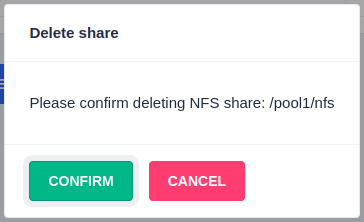NFS shares
Enabling clustered NFS
Note
Before enabling NFS please ensure all relevant packages (i.e. nfs-kernel-server) are installed and enabled on all nodes in the cluster.
By default RSF-1 does not manage NFS shares - the contents of the /etc/exports file are
left to be managed by the system administrator manually on each node in the cluster.
To enable the management of the exports file from the webapp and
synchronise it across all cluster nodes, navigate to
Shares -> NFS and click ENABLE NFS SHARE HANDLING:

Once enabled the shares table will be shown:

Before creating new shares the option to import the existing
/etc/exports file is available (this option is disabled once any new
shares are added via the webapp):
Clustering an NFS share
-
Navigate to
Shares -> NFSand click+Addon the NFS table to fill in the required info. The available options are:Description- Description of the Share (optional)Path- Path of the directory/dataset to share - for example/pool1/nfsExport Options- For a detailed description of the available options click theSHOW NFS OPTIONS EXAMPLESbutton.

-
Click
✓to add the share:
The share will now be available and clustered.
FSID setting for failover
NFS identifies each file system it exports using a file system UUID or the device number of the device holding the file system. NFS clients use this identifier to ensure consistency in mounted file systems; if this identifier changes then the client considers the mount stale and typically reports "Stale NFS file handle" meaning manual intervention is required.
In an HA environment there is no guarantee that these identifiers will be the same on failover to another node (it may for example have a different device numbering). To alleviate this problem each exported file system should be assigned a unique identifier (starting at 1 - see the note below on the root setting) using the NFS fsid= option, for example:
/tank 10.10.23.4(fsid=1)
/sales 10.01.23.5(fsid=2,sync,wdelay,no_subtree_check,ro,root_squash)
/accounts accounts.dept.foo.com(fsid=3,rw,no_root_squash)
Here each exported file system has been assigned a unique fsid thereby ensuring that no matter which cluster node exports the filesystem it will always have a consistent identifier exposed to clients.
For NFSv4 the option fsid=0 or fsid=root is reserved for the "root" export. When present all other exported directories must be below it, for example:
/srv/nfs 192.168.7.0/24(rw,fsid=root)
/srv/nfs/data 192.168.7.0/24(fsid=1,sync,wdelay,no_subtree_check,ro,root_squash)
As /srv/nfs is marked as the root export then the export /srv/nfs/data
is mounted by clients as nfsserver:/data. For further details see the NFS manual page.
Modifying an NFS Share
To modify an NFS chare, click the pencil icon to the left of the dataset:

When done, click ✓ to update the share.
Deleting an NFS Share
To delete an NFS share click the trash can icon and then confirm the deletion
